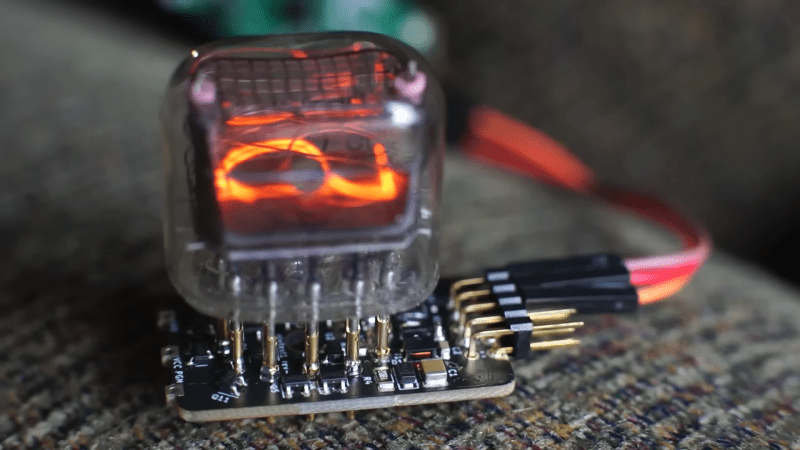Nixie tubes can add some retro flair to any project, but they can also complicate your electronics quite a bit: after all, you need to generate a voltage high enough to ignite the tube and then switch that between ten separate display segments. Traditionalists may want to stick with chunky mains transformers and those unobtainium 74141 segment drivers, but modern components allow you to make things much more compact, not to mention way cheaper. [CNLohr] took this to an extreme, and used clever design tricks and his sharp online shopping skills to make an exceptionally compact Nixie driver circuit that costs less than $2.50.
That price doesn’t include the tubes themselves, but [CNLohr] nevertheless bought the cheapest Nixies he could find: a pair of IN-12B tubes that set him back just $20. He decided to generate the necessary 180 volts through a forward converter built around a $0.30 transformer and a three-cent MOSFET, controlled by software running on a CH32V003. This is one of those ultra-cheap microcontrollers that manage to squeeze a 48 MHz RISC-V core plus a bunch of peripherals into a tiny QFN package costing just 12 cents.
The existing toolchain to program these micros left a lot to be desired, so [CNLohr] wrote his own, called
ch32v003fun. He used this to implement all the control loops for the forward converter as well as PWM control of the display segments – a feature that adds a beautifully smooth turn-on and turn-off effect to the Nixie tubes. There’s still plenty of CPU capacity left to implement other features, although [CNLohr] isn’t sure what to put there yet. Turning the tubes into a clock would be an obvious choice, but the basic system is flexible enough to implement almost anything requiring a numeric display.
The compactness of this circuit is impressive, especially if you compare it to earlier solutions. There’s plenty of fun to be had with cheap-yet-powerful micros like the ch32v003, provided you can find them.















s/CNLorh/CNLohr/g
Thanks! Fixed.
You guys should be paying [CNLohr] a cut of your advertising revenue, he has contributed so much over the years.
I owe Hackaday a deep debt and have just been paying it off. They are *the* reason I pursued electronics on youtube.
OK hugs for everyone then.
lol.
Fantastic. Bizarrely, I bought both Nixies and CH32V003s (independently) a couple of weeks ago!
How so? Neon bulbs turn on and off 120 times/second (or 100 if you live there). How’s this going to be different?
Also not to mention it’s fairly common to have multiplexed driving schemes for nixies and I haven’t heard any significant issues with tube lifetimes due to that. I’d think that since the excitation/extinguishing of the neon isn’t instantaneous and has a natural sort of delay/ridethrough that pulsing them should have negligible effect but then again I’m sure there’s a lot more going on in terms of physics and materials science when it comes to nixies that I’m unaware of.
That´s a question Dalibor Farny might be able to answer. He pushed the nixie engineering and quality testing at a level nobody else reached in the past.
https://www.daliborfarny.com/
Great project, congrats.
A nice example of a modern Nixie driver. You really don’t need much, beyond a bunch of small HV mosfets to control them. Getting a 5V->180V power-circuit that small is pretty dang impressive. I’m used to using bulkier MC34063 booster circuits.
Surprised about the price though. The IN-12B used to be the cheapest and most common of the nixies, now it seems that they are rarer and more expensive than even the smaller IN-17. Guess their popularity for kits combined with the ongoing war really did a number on them.
S. C. R.
re: link. Tossed that in. Good call.